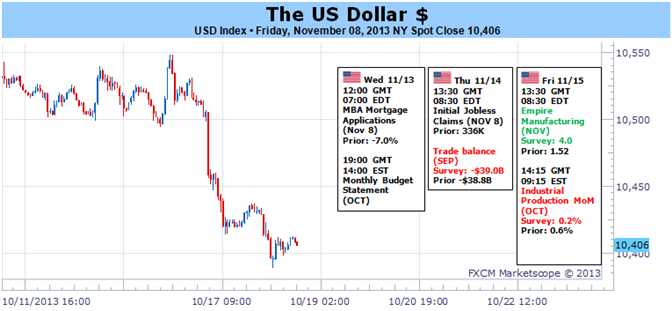
US Dollar Attempts Major Reversal as Taper, Risk Debate Heats Up
Fundamental Forecast for US Dollar: Bullish
The Taper timeline is shifting from a March 2014 forecast to either the January or December meeting
An ECB rate cut puts another major central bank on the easing path which indirectly bolsters the dollar
The dollar’s path depends heavily on a December vs March Taper? Trade the US Dollar’s via our Mirror Trader currency basket
The dollar finished the week higher against nearly all of its major counterparts with particularly impressive performances from EURUSD and USDJPY. While some of this bullish drive can be attributed to cross winds, the greenback generated its own heat by tapping into both QE expectations and risk trends. This week, we will see whether the persistently rising tide of volatility can finally ignite the critical, underlying fundamental themes and produce the heavy trends of years past.
Given the key event risk this past week, the most promising catalyst moving forward for the dollar – and broader financial market – is renewed speculation over the timing of the FOMC’s Taper schedule. A month ago, the central bank curbed fear that the stimulus backstop on risk-taking would soon be trimmed when it defied expectations and deferred the Taper (a reduction in its $85 billion-per-month QE3 program) at the September 18 meeting. With the US government shutdown shaving off an estimated 0.6 percentage points off 4Q GDP and delaying key data, a multi-meeting postponement of the moral hazard withdrawal seemed clear. Working with an economist survey from Bloomberg, it was expected that the reduction in support wouldn’t occur until at least the March 18, 2014 meeting. Yet, optimism in external support (QE) has cooled significantly over the past few weeks…and the dollar is positioned to take advantage.
In the statement from the Fed’s October policy meeting, the central bank notably resisted expectations for a move dovish tone to accommodate the recent fiscal troubles. Quite the contrary, the group noted further economic improvement and dropped their mention of concerns from fiscal sources. This past week, we were given data that further erodes the ‘QE-forever’ mentality. The better-than-expected 2.8 percent 3Q GDP reading was a backdrop improvement but skeptics could reason it is a dated reading. Less controvertible was the October NFPs which bested expectations despite the federal furlough through the period. The 204,000 jobs added to the payrolls beat, though the unemployment rate did tick higher to 7.3 percent. There is plenty of debate over whether this data is ‘accurate’, but the Fed’s statement suggests they would view it as supportive.
Without a comprehensive survey to offer us a benchmark for the change in investors’ or economists’ expectations on the Taper time frame, we have to rely on the market. On that front, the benchmark 10-year Treasury yield posted its biggest rally in four months on Friday to return to 2.748 percent (yields rise as the bonds themselves drop with investors exiting before the Fed makes its move). For the other QE target asset – MBS (mortgage-backed securities) – the iShares MBS ETF plunged through the end of the week.
From these and other market changes, there is a measurable forward shift in expectations for the Taper from the March 18 meeting to the January 29 or perhaps even the December 18 meet – which is one of the quarter events that will provide updated forecasts and a press conference by the Chairman. However, the extent of how market-moving this is depends on how important such an alteration is to investor confidence. In other words, we need to see whether expectations of an earlier QE cut rallies the dollar.
There are two ways that the greenback can be guided by this theme: via a speculative response and/or a ‘reserves capital’ channel. The risk aspect is straightforward. Given the Fed’s prominent position in propping up the global financial system and economy via its early and expansive stimulus regime, the start of a withdrawal can expose serious risk in record high prices and leverage in capital markets. And, in a global scramble for safety, the world’s largest economy and reserve will play its role.
From a different angle, pumping the break on stimulus can shift forward rate expectations and work off discounts further down the curve. This aspect has gained far more potential though through the recent dovish shift from the ECB. A rate cut and vows of liquidity for the banking sector reverses confidence and a steady flow of reserves. If the Fed does indeed head for a Taper, it would draw stark contrast to the BoJ (likely to pursue a second QE), the BoE sitting pat on rates through 2016 and now the ECB. FX is always a ‘relative’ market. – JK
DailyFX provides forex news and technical analysis on the trends that influence the global currency markets.Learn forex trading with a free practice account and trading charts from FXCM.
Source: Daily fx
